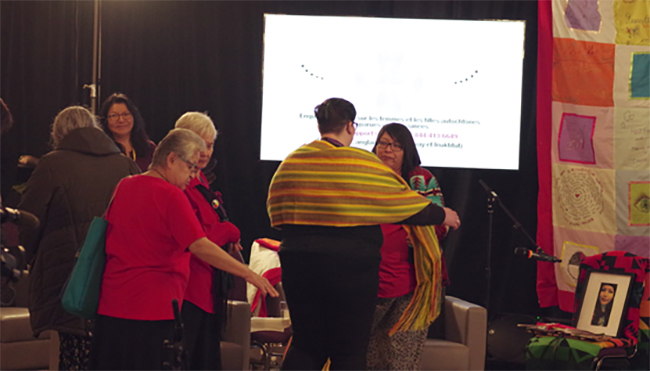Red dress pins honour those who are missing or murdered

By Rick Garrick
THUNDER BAY – Biinjitiwaabik Zaaging Anishinaabek’s Diane Hardy participated in two testimony sessions with her family, handed out red dress pins and performed with her hand drum at the Thunder Bay Community Hearings for the National Inquiry into Missing Murdered Indigenous Women and Girls.
“The reason I am here is because I lost one sister (Doreen Hardy) 51 years ago,” Hardy says on Dec. 5. “The family will be testifying this afternoon, but it will be in private. I had an interview with the OPP about a month ago about something to do with some new information and it was very hard, so I can imagine what we are going to be going through this afternoon.”
Hardy handed out the red dress pins that she and Sheila Karasiewicz, from Fort William, made after being inspired by Jaime Black, a Métis artist from Winnipeg whose goal was to collect 600 red dresses for installation in public spaces across Canada.
“I made 500 of them to honour all the ladies that are missing or murdered,” Hardy says. “So anyone that comes here will get a red dress to remember also with us.”
Hardy also sat with her great niece during her testimony on the first day of the Community Hearings, which were held from Dec. 4-6 at the Best Western Plus Nor’Wester Hotel and Conference Centre.
“She lost her mom in B.C.,” Hardy says. “It was pretty emotional in there yesterday.”
Hardy was also one of the women who performed hand drum songs to bring in the families to deliver their testimony during the Community Hearings.
“It is important to note that this process is allowing the families to give dignity to the women,” says Fort William Councillor Michele Solomon. “The way they are portrayed and characterized in media is often not in a very nice way and focuses on the shortcomings that poverty and colonialism has left our people in. This is really an opportunity for us to give that dignity back to the women that have been lost.”
Solomon adds that she appreciates how the Community Hearings accommodated the way that Indigenous people give testimony.
“I believe that they have been dealt with in a respectful way and I believe that there has been a lot of support around the people that are giving testimony,” Solomon says. “It is definitely set up in a community context so that the community can come and be with the people who are giving testimony, not just the support people that are paid to be here but also community supports and natural helpers.”
Solomon says the National Inquiry is a first step towards healing for people who have lost a loved one through violence.
“The beauty of it is that the families can come together and support each other,” Solomon says. “They know they have all lost somebody, but this is the first time that they actually sit and listen to each other’s stories.”
Ron Kanutski, the master of ceremonies and a Red Rock Indian Band citizen, appreciated the emphasis on the traditional healing practices at the Thunder Bay Community Hearings.
“That’s been very valuable in keeping people’s wellness into perspective and keeping people balanced while they are going through this difficult process,” Kanutski says. “They are using a lot of the medicines and some of the ceremonial tools they have to guide them through. I think it’s been pretty valuable assisting people who are dealing with their grief and giving them the strength to press forward.”


